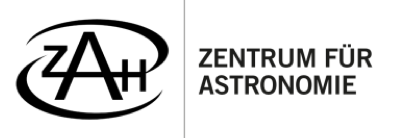Astronomers Create Most Detailed Colour Map of the Sculptor Galaxy - a Technical and Scientific Triumph also Featuring Heidelberg Expertise
Heidelberg, 18 June 2025 - An international research team led by the European Southern Observatory (ESO) has released a detailed thousand-colour image of an external galaxy, observed using the Multi Unit Spectroscopic Explorer (MUSE) at ESO’s Very Large Telescope (VLT). This ultra-detailed image reveals previously unseen features in the Sculptor Galaxy, with key scientific contributions from Heidelberg University researchers. The study "The MUSE view of the Sculptor galaxy: survey overview and the planetary nebulae luminosity function" will appear in the science journal Astronomy & Astrophysics.
A galactic masterpiece
The study required over 50 hours of VLT observing time, compiling more than 100 exposures across a 65,000-light-year-wide region at the distance of the observed Sculptor Galaxy (NGC 253). This project represents one of the most sophisticated large-scale integral-field spectroscopic surveys ever executed. The data-cube retrieved with ESO's flagship integral field spectrograph MUSE delivers a full spectrum at each position in the galaxy. The result is a data set ideally suited for a deep dive into understanding the age, chemical composition, and motion of stars, gas, and dust across the galaxy's disc.
Key Astronomical Discoveries
As highlighted by Heidelberg co-author Dr. Kathryn Kreckel, this dataset lets astronomers “zoom in to study individual regions where stars form at nearly the scale of individual stars, but we can also zoom out to study the galaxy as a whole”. Dr. Kreckel, research group leader at the Centre for Astronomy of Heidelberg University (ZAH), took a leading part in the scientific interpretation of the data.
The initial analysis has revealed approximately 500 planetary nebulae, five times more than can typically be observed for more distant galaxies. Fabian Scheuermann notes: “Beyond our galactic neighborhood, we usually deal with fewer than 100 detections per galaxy". Fabian Scheuermann, a PhD candidate in Dr. Kreckel’s research group, provided expertise on the identification and analysis of the planetary nebula population. Since these nebulae serve as precise distance markers, discrepancies between the new result and past work allowed the team to conclude that in the presence of too much dust, these planetary nebulae may not provide reliable distances.
Technical Innovation & Benefits for Astronomy
This new spectroscopic mosaic of the Sculptor Galaxy will allow mapping of stellar ages, chemical gradients, and kinematics across the full galaxy, paving the way for new insights into how galaxies grow, interact, and evolve. The result demonstrates the power and scalability of the integral-field spectroscopic technology provided by MUSE. Projects such as ESO’s future ELT/MOSAIC instrument will build directly upon this success for even more distant galaxies.
By publicly releasing the Sculptor Galaxy dataset, researchers involved in this project are opening numerous research avenues to the entire scientific community for further studies including: tracing gas flows, investigating chemical evolution, and charting star formation at unprecedented resolution.
ORIGINAL SCIENCE PUBLICATION
The MUSE view of the Sculptor galaxy: survey overview and the planetary nebulae luminosity function, E. Congiu, F. Scheuermann, K. Kreckel et al., 2025, https://arxiv.org/abs/2506.14921, accepted to appear in Astronomy & Astrophysics
ADDITIONAL INFORMATION
ERC and Emmy Noether Research Group on Baryonic Life Cycle at ZAH/ARI
This research group is led by Dr. Kathryn Kreckel and hosted at the Astronomisches Rechen-Institut (ARI), which is part of the Centre for Astronomy of Heidelberg University (ZAH). Her group aims to understand the physical processes and local conditions that drive galaxies buildup of stellar mass through star formation. This evolution is regulated through the baryon cycle, the transformation of gas into stars and eventual ejection and recycling of that material to form the next generation of stars. For more information see https://wwwstaff.ari.uni-heidelberg.de/kkreckel/.
Data availability
All reduced MUSE data cubes, emission-line maps, kinematic products, and the full PNe catalog are publicly accessible via the ESO archive and the CADC/Vizier services.
FURTHER READING
ESO Press Release and High Resolution Image of the Sculptor Galaxy
Centre for Astronomy of Heidelberg University
PHANGS-Muse survey
SCIENTIFIC CONTACT
Fabian Scheuermann
Centre for Astronomy of Heidelberg University (ZAH)
f.scheuermann@uni-heidelberg.de
https://www.fschmnn.com/
Dr. Kathryn Kreckel
Centre for Astronomy of Heidelberg University
kathryn.kreckel@uni-heidelberg.de
https://wwwstaff.ari.uni-heidelberg.de/kkreckel/
CONTACT FOR MEDIA INQUIRIES
Dr. Guido Thimm
Centre for Astronomy of Heidelberg University (ZAH)
thimm@uni-heidelberg.de

